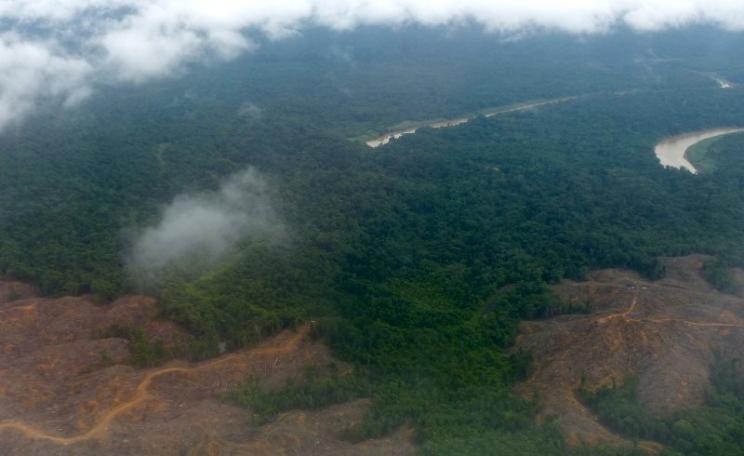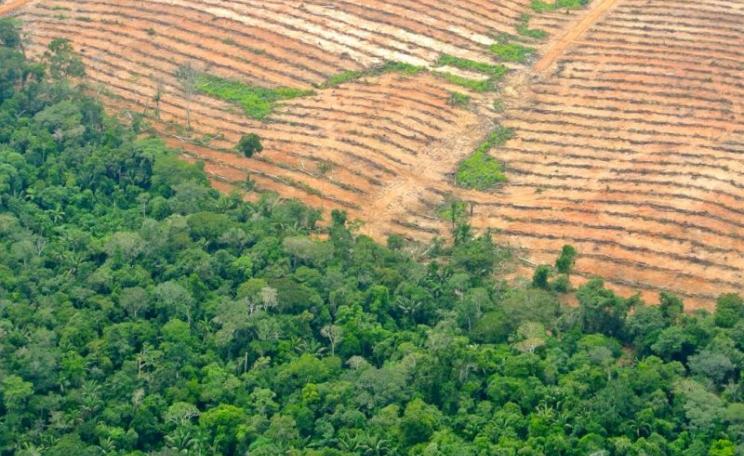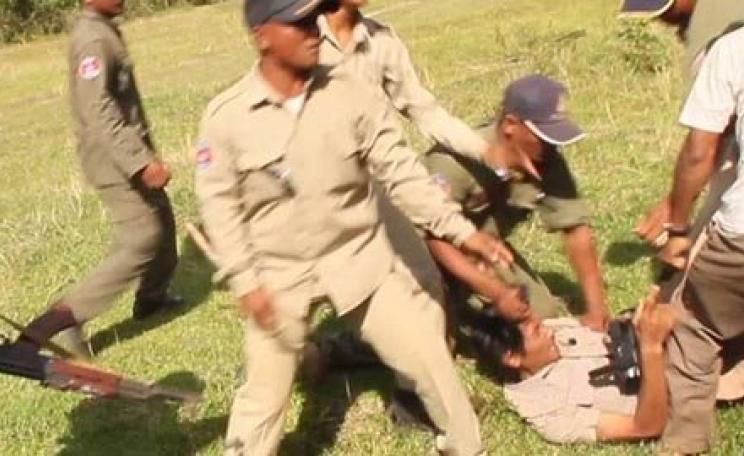Prey Long Network discover a cache of illegally cut resin trees in Prey Long forest. Photo: © Vanessa de Smet.
We are not afraid. Our community upholds the law. The illegal loggers are the ones who should be afraid.
Globally there has been a surge in deforestation in the first quarter of 2014. Since January, NASA has detected sharp increases in deforestation across the world - 162% in Bolivia, 150% in Malaysia, 63% in Nigeria and 89% in Cambodia.
Our research on deforestation in Cambodia has found that forests are better protected when local communities are given the responsibility to manage them locally.
But all too often, community leaders who raise their voices to protest against deforestation are at risk of losing their lives.
The environmental justice group Global Witness recently released a report showing that local people who stand up to defend their lands and forests are targeted and killed at a rate of more than one per week. Between 2002 and 2013, nearly 1,000 activists were killed in 35 countries.
Murder in the Cardomom mountains
Cambodia's foremost forest activist, Chut Wutty, was killed in 2012 at an illegal logging site he was investigating in the Cardamom mountains. A keen proponent of community forest patrols and law enforcement, Wutty spearheaded the Prey Long Network an activist group that aims to protect the whole of Prey Long forest.
Since his tragic death, people living in Prey Long continue to actively defend the forest - despite the threats.
A young activist told me, "After Wutty's death our community was threatened by outsiders. They said 'Aren't you afraid of dying, like Wutty did?' But we are not afraid. Our community upholds the law. The illegal loggers are the ones who should be afraid."
Cambodia has one of the highest rates of deforestation in the world, losing 1.2% each year from 2005-2010. The loss of forests due to illegal logging, commercial agriculture, hydropower dams and mining has had a devastating impact on communities in Cambodia.
In a country beset by corruption and ineffectual state forest management, alternative models are clearly needed.
The curse of Siamese rosewood
Prey Long is one of the last lowland evergreen forests of mainland Southeast Asia, covering over 5,000 square kilometres. But the landscape is increasingly at risk from advancing rubber plantations and rapacious timber cartels.
It's attracting the loggers because of the many rare and precious tree species in the forest, including prized Siamese rosewood (Dalbergia cochinchinensis), highly sought-after in international timber markets despite being officially protected. The wood can fetch as much as $50,000 per cubic metre in its raw state.
Demand is especially strong in China for reproduction 'hongmu' furniture and ornaments, as highlighted in a recent report by the Environmental Investigation Agency, which found a single hongmu bed on sale in Shanghai for $1 million.
We are not afraid. Our community upholds the law. The illegal loggers are the ones who should be afraid.
And Cambodia is one of the main source countries for the timber.
A CITES listing - but it has done little to help
In June 2013 the tree was listed by CITES, the Convention on the Trade in Endangered Species, as an Appendix II species. This does not wholly prevent trade, but requires countries to ensure that the trade is sustainable. As the EIA explains,
"Under CITES Appendix II, species cannot be exported from range state producer countries without CITES export permits issued by relevant management authorities, with those in turn being issued on the basis of scientific authority confirmation that such trade will not be detrimental to the survival of the species.
"Range states are also obliged to pre-notify the CITES Secretariat regarding quotas for harvest and trade before any CITES export permits can be issued."
But the restrictions have yet to have any significant effect on the ground. Widespread corruption in Cambodia means that certificates can be illegally purchased to accompany exported logs - no matter what their origin. Most border guards are easily paid off out of the enormous profits to be made from exporting the rosewood logs.
Is community forestry the solution?
Our study, published in the latest issue of Conservation Biology, looked at how effective community forestry is at reducing deforestation in Prey Long forest. These findings reflect a recent report in The Ecologist from Casamance in Senegal'
We found that community patrolled areas showed significantly better forest condition than state managed areas. That comprised, fewer signs of damage, greater above ground biomass, greater regeneration and increased canopy cover.
Most community forest protection in Prey Long has been established since 2005, so this is an important result showing the effectiveness of community protection over a short time period.
In Prey Long local communities patrol the forest looking for loggers or cut trees. They make a contract with the loggers they catch, confiscate their equipment and inform the local Forest Administration. But often the response is desultory at best.
Chut Wutty therefore trained patrols to burn the timber on the spot: destroying loggers' profits and preventing corrupt gains by the authorities.
Local communities depend on the forest
Approximately 250,000 people live in 340 villages within the Prey Long landscape. They rely heavily on forest products as a source of income, and especially on 'resin trees' - species of Dipterocarp that produce natural resins collected by local people and sold for use in industry as a base for paints, varnish, and even perfume.
The sustainable use of resin trees, which can only grow in native forest and provide livelihood support to local people, is a conservationist's Holy Grail. Resin collection only works when the trees are standing and are alive. The trees therefore provide a strong incentive to protect the forest.
But ways of life in Prey Long are transforming as wage labour is increasingly common and long-standing traditions of natural resource use are eroded through deforestation.
Communities need external support
Moreover the communities' law enforcement efforts require external support if they are to stem the tide of illicit timber trucks.
In a forthcoming documentary charting his work, Wutty said, "In some places people rise up by themselves to protect their natural resources. They work together and respect the law. I believe if donors support the people's goals, success can be achieved."
Yet there is little international support for local forest protection efforts. USAID has put almost $20 million into 'sustainable forestry and biodiversity' in the Prey Long landscape. On paper, the Prey Long Network is an important part of the protection effort, and is written into the project document.
However, the network's role seems to have been sidelined as more powerful interests muscle in on the available money.
With deforestation in Prey Long accelerating, this is a crucial time to support the efforts of local communities. Indeed, it is the only chance to save our besieged forests, in Cambodia and beyond.
Fran Lambrick first went to Cambodia in 2004, and has been back five times since. Over the last four years she has been doing PhD research at Oxford on community forestry in Cambodia.
Her forthcoming documentary film is the culmination of three years living and working in Prey Long forest.
Also on The Ecologist: 'Community forestry is defusing Africa's longest-running conflict' - Louise Hunt reports from the Casamance region of Senegal.





